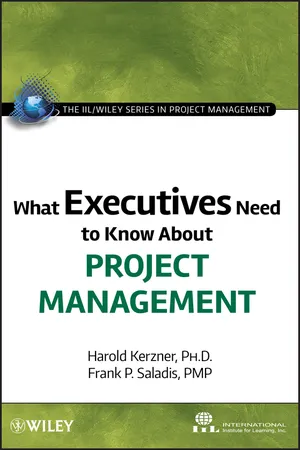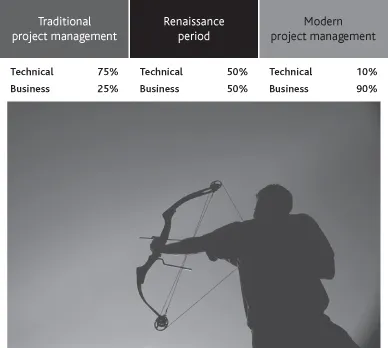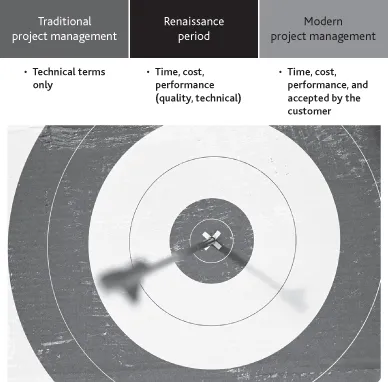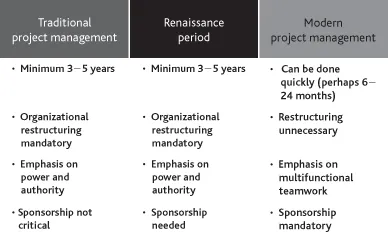
What Executives Need to Know About Project Management
Harold Kerzner, Frank P. Saladis
- English
- ePUB (adapté aux mobiles)
- Disponible sur iOS et Android
What Executives Need to Know About Project Management
Harold Kerzner, Frank P. Saladis
À propos de ce livre
As project management has evolved and matured, so has the executive's role in project management. To ensure the success of individual projects and the organization as a whole, today's executives are increasingly involved in activities such as capacity planning, portfolio management, prioritization, and strategic planning specifically for project management. In fact, more and more executives are becoming certified Project Management Professionals (PMPs).
What Executives Need to Know About Project Management offers executives a guide to project management, focusing on what they need to know and what they need to do. It provides step-by-step guidance to help executives get effective, well-resourced project management teams in place and ensure the success of any individual project.
The book begins with basic principles, including a detailed discussion of the three best practices that enable executives to ensure effective project management:
- Developing an environment where project management is viewed as a profession
- Securing key personnel for project management positions
- Creating opportunities for rewards and advancement through successful project management
Next, the book explores how executives serve as executive sponsors in project management teams, setting forth solutions to the many problems and challenges they face in this role, including managing disagreements, delegating authority, and accelerating projects.
The authors explain how the role of the executive sponsor changes depending upon the life-cycle phase of the project. For example, during the project initiation and planning phases, the sponsor may take on a very active role, ensuring that proper objectives are established and that the project plan satisfies the needs of the business as well as the needs of the client. During the execution phase, the sponsor may take on a less active role; however, the book shows how executive sponsors need to become involved when roadblocks appear, crises occur, and conflicts arise over priorities among projects.
Throughout the book, helpful illustrations clarify complex concepts and processes.
Foire aux questions
Informations

- Unique or one-of-a-kind deliverables
- A well-defined objective
- Predetermined constraints regarding time, cost, and performance/technology/quality
- Requires the use of human and nonhuman resources
- Has a multidirectional work flow

- Money. Once budgets are established and charge numbers are opened, project managers focus more on project monitoring of the budget rather than management of the budget. Once the charge numbers are approved and opened, the respective line managers or functional managers control the budgets for each work package.
- Resources. The human resources required for the project are usually assigned by the line managers, and these resources may be under the direct control of the line managers for the duration of the project. Also, even though the employees are assigned to a project team, their line managers may not authorize them to make decisions that affect the functional group without first obtaining approval from the line managers.
- Business knowledge. Project managers are expected to make decisions that will benefit the business as well as the project. This is why executives must interface with projects—to provide project managers with the necessary business information for decision making.

- 1960–1985. This can be referred to as the period of traditional project management. Project management was restricted to aerospace, defense, and heavy construction industries. Project management was used on mega projects only.
- 1986–1992. This was the Renaissance period, or great awakening, where we learned that a project management methodology could be used on a multitude of projects and benefit nearly all industries. Project management became readily accepted in industries such as automotive, information systems, telecommunications, and banking.
- 1993–2009. Project management became readily accepted in all industries and applicable to any size project. Project management was viewed as a career path, and interest in project management certification credentials grew. Companies began to recognize that project management can increase profitability and improve working relationships with customers while increasing competitive edge.


- Additional business with the client
- The client acts as an advocate for your company
- Increased market share
- Shorter time to market

Table des matières
- Cover
- Title page
- Copyright page
- PREFACE
- ACKNOWLEDGMENTS
- INTERNATIONAL INSTITUTE FOR LEARNING, INC. (IIL)
- Chapter 1 PROJECT MANAGEMENT PRINCIPLES
- Chapter 2 THE EVOLUTION OF PROJECT MANAGEMENT
- Chapter 3 THE BENEFITS OF PROJECT MANAGEMENT
- Chapter 4 THREE CORE BEST PRACTICES
- Chapter 5 ROLE OF THE EXECUTIVE AS A PROJECT SPONSOR
- Chapter 6 SPECIAL PROBLEMS FACING EXECUTIVES
- Chapter 7 NEW CHALLENGES FACING SENIOR MANAGEMENT
- Chapter 8 ADDITIONAL RESPONSIBILITIES FOR EXECUTIVES
- Index